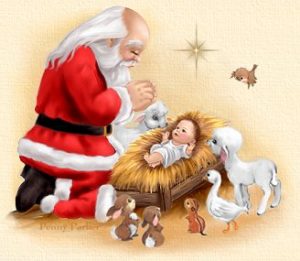I’ve found myself wondering of late what someone from a relatively unchristianized country might think of the American celebration of Christmas. The dialogue might sound something like this:
“Well, see, it’s like this. The two most important people at Christmas time are Santa Claus and baby Jesus. Which one is more important depends on who you ask. Christmas is the time we remember the birth of Jesus in a feeding trough around 2,000 years ago. (No one knows exactly when he was born, so we took an old pagan holiday on December 25 and turned it into Christmas.) That’s why you see so many scenes of a baby surrounded by animals and a few people. But none of them are wearing red suits with big black buttons — that’s Santa Claus, who they call Father Christmas in the UK and other Commonwealth countries. The story goes that he lives at the North Pole and makes a visit every year to hand out presents, coming down the chimney if your house has one. Parents of young children love to put their sometimes terrified children in the lap of an old guy dressed up to look like Santa. Most people don’t know where Santa Claus comes from, but rumor has it he is a devolved version of a man named Nicholas who lived in what is now Turkey many years ago and was apparently an incredible guy. Parents agonize over whether to raise their children believing Santa really exists and dreading the day they find out he doesn’t — or just telling them from the start that he’s no more real than Frosty the Snowman.”
“Who’s that?”
“Oh, you don’t know Frosty either? He’s one of a thousand characters that make up the myriad of stories that are pulled out at Christmas time. Like Rudolph the Red-Nosed Reindeer. (Somewhere along the line Santa Claus acquired a whole herd of reindeer. And he has lots and lots of elves who help him in his workshop. I’m not sure how much they think about baby Jesus.)
You see, Christmas is about way more than Jesus OR Santa; it’s a time to feel all warm and cozy and watch schmaltzy movies and treat each other nicer than usual. We call that the Spirit of Christmas. We give each other presents — so many that Christmas shopping counts for 20% of American retailers’ annual profits. And giving to non-profits for one last tax deduction is part of that spirit, I suppose.
And we sing songs which we call carols. No idea why we call them that, but no other songs we sing throughout the year are called carols. They’re about the birth of Jesus, Santa Claus, other characters as mentioned above…and winter — especially songs that make you feel warm and cozy in spite of the winter cold. (Here in the States we don’t really think about the millions of people who celebrate Christmas on or below the equator — that just doesn’t make sense to us and would mess everything up.)
And of COURSE there’s food. Lots of it, especially sweets. Not sure how baby Jesus feels about the amount of weight gained in this country at this time of year. But who doesn’t love a slice of pumpkin pie or peppermint bark or bourbon bonbons or fudge or…I could go on. And somewhere, some time, someone decided that if two people were found standing together under some mistletoe, a parasite that grows on trees, they have to kiss each other. But you never hear mention of mistletoe at another time of year, so I’m not sure it counts if you’re looking to kiss someone.
On Christmas Eve, some people go to church, where most of the songs are indeed about the birth of Jesus. Then you go home to listen to the rest. It’s a time for families to get together, specifically around an evergreen tree decorated with all kinds of ornaments and keepsakes.”
“What does the tree have to do with the birth of Jesus?”
“Uh, no idea. In fact, the tree thing probably dates back to the pagans as well, but oh, we love our Christmas trees.
In fact, most of us love pretty much all of it.
Does this help?”
